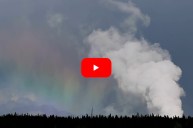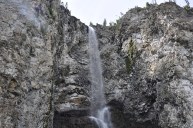Yellowstone National Park is home to wildlife, sacred Crow and Cheyenne Native lands, and great sites that you really cannot see anywhere else in the world. Cornered by Idaho and Montana in the northwest corner of Wyoming, this national park is sure to be on any explorer's bucket list of places to go.
Yes, it's right up there with the Grand Canyon. There are many reasons why Yellowstone was the first area to be added to the National Park Service (NPS).
Yellowstone National Park boasts a wide array of geological and geothermal features that human eyes have traveled far and wide to witness in real life. The park is home to one of the most famous geysers, "Old Faithful," pits of boiling waters, mudpots, fumaroles, and 10,000 interesting hydrothermal features.
With Old Faithful, Yellowstone National Park should be at the top of that bucket list.
Old Faithful at Yellowstone National Park
https://www.instagram.com/p/CPW-hEojzcJ/?utm_source=ig_web_copy_link
You have seen the pictures of the jet-setting stream of liquid shooting high into the sky, but do you know what geysers are? Did you know that half of the world's active geysers are located in Yellowstone? The last count says that in 2011, 1,283 geysers were recorded as erupting in the park, which is a magnificent feat as the rest of the world's geysers total less than 500.
What is a Geyser?
https://www.instagram.com/p/CORiTmiHaMd/?utm_source=ig_web_copy_link
Yellowstone's geysers are pretty fascinating. Geysers are erupting hot springs that shoot out periodically due to the underground's super-heated waters that become trapped in channels forced to the surface. Because the deep hot water can't vaporize, the steam gets sent upwards in bubbles that collect and clog until they cause the geyser to overflow. The pressure sees a slight decrease until all of a sudden, violent bubbling occurs so much that the incredible force off steam vents out as a concentrated mass — a geyser eruption (who knew you were headed to science class today?).
The Old Faithful Geyser
https://www.instagram.com/p/CRXDx_ps4hj/
RELATED: The Famous Gold Mine of Lost Dutchman State Park
The Old Faithful geyser, the most famous of the park's geysers, was made a National Historic Landmark in 1987 and erupts approximately 20 times a day, within a 10-minute average interval at a 90% accuracy rate. Park rangers and naturalist staff who predict the next eruptions do with information like the duration and height of the previous eruption.
When you visit the park, you can watch the geyser from the observation point and other secured viewing areas in the Old Faithful area of the Upper Geyser Basin. Make sure to check for predicted eruption times inside most buildings around the park. You can also watch some of the hundreds of active geysers in the park by visiting the Midway Geyser Basin, the Lower Basin, the Norris Geyser Basin, and the other geyser basins in Yellowstone.
Seeing Old Faithful erupt is an earthly phenomenon you do NOT want to miss! You can even stay the night at the Old Faithful Snow Lodge, Grant Village, or the Old Faithful Inn and learn more about the geysers at the Old Faithful Visitor Education Center. Do not fret if you cannot make it to the park; you can watch the magic on the live stream webcam available here.
Hydrothermal Features & Other Fun Facts
https://www.instagram.com/p/CN6diqjheoP/?utm_source=ig_web_copy_link
The hydrothermal and thermal features at the park draw an average of 4 million visitors each year! The park showcases more than 300 geysers, one of the world's largest calderas, Yellowstone Lake, thousands of petrified trees, and around 290 waterfalls over 15 feet. Its tallest is 308 (the Lower Falls in the Yellowstone River).
The most photographed site at the park is the mind-blowingly cool Grand Prismatic Spring, the third-largest spring in the world at 370 feet in diameter. The spring boasts its bright bands of rainbow colors from the different types of heat-loving bacteria that live in the water.
The scientific research done in the spring has led to discoveries for NASA, criminal investigations, and revelations in the science community. Because the area is so critical and dangerous, always stay on the designated trails and boardwalks when you visit.
Need an adventure? Find some inspiration at our Wide Open Roads Facebook page!




